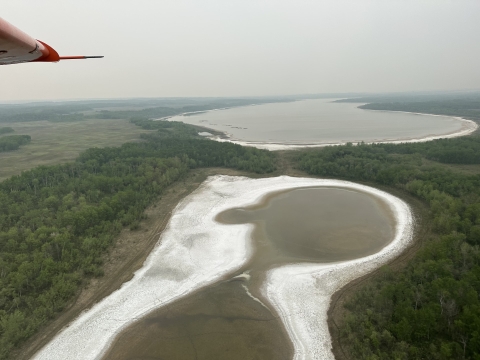About this Collection
By Mark Koneff, Branch of Migratory Bird Surveys
Wait, Hurry Up, and Wait Again: The 2023 Waterfowl Breeding Population and Habitat Survey
It’s that time of year again! In April, our aerial and ground survey crews were busy preparing for the Waterfowl Breeding Population and Habitat Survey (WBPHS). The WBPHS is the largest and longest running wildlife survey in the world and its results have, since the 1955, guided waterfowl harvest and habitat management, and has been used by researchers worldwide to shed light on large-scale dynamics of migratory species. The primary purpose of the WBPHS is to provide information on spring population size and trends for most North American duck species, several populations of Canada geese, tundra swans, and American coot, and to evaluate breeding habitat conditions.
The survey is conducted by airplane, helicopter, and ground over a 2 million square mile area that covers the principal breeding areas in North America, and includes parts of Alaska, Canada, and the northcentral and northeast U.S. This survey is also referred to as the Breeding Population Survey (BPOP) or the May Survey.
As we approach May each year, its normal for anticipation to build for the air and ground crews, however, as of late April it was looking like spring was running late in some areas – our survey crews covering the prairies and western boreal forest planned for departures a week later than most years. But then … enter the “omega block” … and the picture was looking quite a bit different just a couple of weeks later. Omega blocks are upper atmospheric blocking patterns that are formed when a ridge of high pressure pushes north, causing a jet stream pattern resembling the Greek letter omega. This pattern can become very stable and lock into place, hence the term block. Under the high-pressure ridge, clear, warm conditions can persist for weeks while the low-pressure throughs on either side of the ridge are characterized by cool, wet conditions. Omega blocks are not uncommon this time of year, however, the extreme heat across the prairies and western boreal forest in May under the ridge was very unusual.
I’ve seen several reports that, historically, a “heat dome” event of that severity at that time of year might occur 1 in every 1,000 years or even less frequently. Of course, when it comes to climate in recent decades, extreme events have become more commonplace. That extreme heat not only rapidly advanced spring across the mid-continent and west but it greatly elevated fire risk and helped spawn several large and destructive forest fires in Alberta, Canada. The rapid advance from winter to spring-, and even summer-like conditions left crews scrambling to catch up and ensure the survey occurred during the narrow biological window that we targeted, only to be slowed again after starting the survey due to thick smoke and very poor visibility extending across the prairies and parts of the western boreal forest.
Despite the challenges, nine Service aircrews and two ground crews collaborated with three aircrews and three ground crews of the Canadian Wildlife Service to again contribute to this long-term dataset that has been so critical to effective management of waterfowl in North America.
The story of the 2023 survey was wait, hurry up, and wait again, but survey crew leaders, with experience, quickly learn the importance of patience and flexibility in getting the survey done efficiently and safely.
Please click on the individual field reports to read the first-hand observations from our pilot biologists and ground crews on what they saw during the 2023 May Survey.


